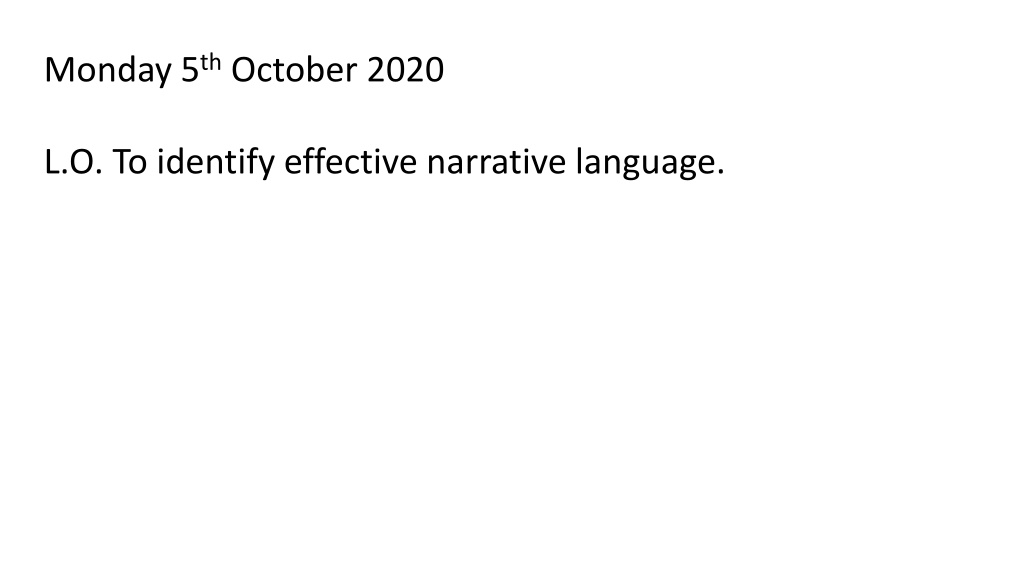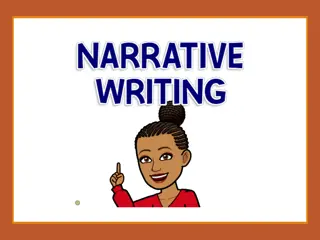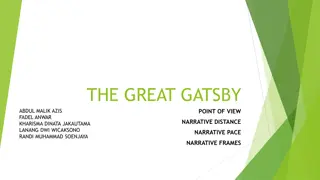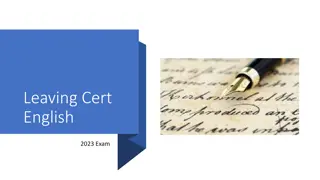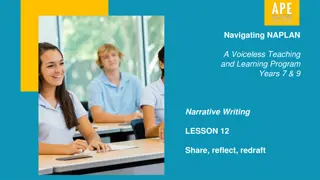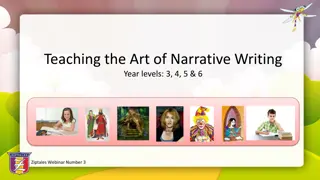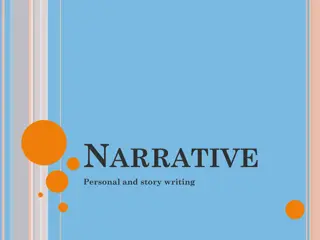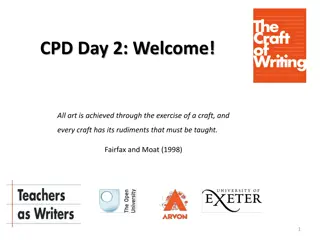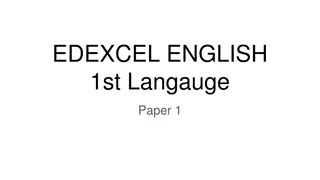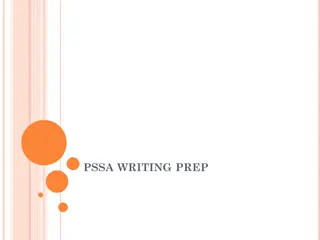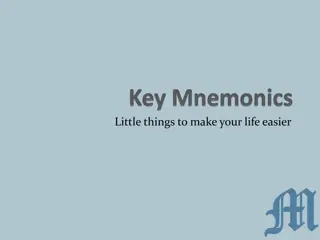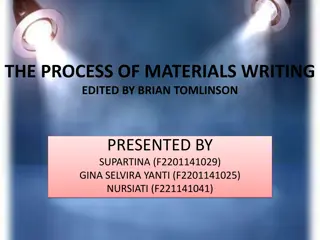Exploring Effective Narrative Language for Writing Success
Delve into the art of crafting compelling narratives by identifying and utilizing effective narrative language techniques. Explore the elements that make a good narrative, practice identifying literary techniques, and understand the impact of figurative language on storytelling. Enhance your writing skills through engaging activities and discussions.
Download Presentation

Please find below an Image/Link to download the presentation.
The content on the website is provided AS IS for your information and personal use only. It may not be sold, licensed, or shared on other websites without obtaining consent from the author. Download presentation by click this link. If you encounter any issues during the download, it is possible that the publisher has removed the file from their server.
E N D
Presentation Transcript
Monday 5th October 2020 L.O. To identify effective narrative language.
Today we start a topic of writing and are looking into a different text type. We will be unearthing what makes a good Narrative. What is a narrative? A narrative, story or tale is any account of a series of related events or experiences. We are going to look at what makes a good narrative and the elements that you will try and include to make your narrative a successful one. The Frozen Kingdom The narrative chosen is called - Who can infer what this narrative might be about?
How do we identify? We are going to read the piece of text first. Then I want you to underline anything that you feel sounds really great and you think the author has used a form of literary technique. We will then revisit these as a class and discuss what type of technique this may be.
How many of these do you know? How many of these are you confident in using?
Its your turn! Look back through the words or phrases that you underlined and attempt to work out what type of figurative language you have underlined. Write this next to the wording. Challenge What effect does this language have on the reader?
Tuesday 6th October 2020 L.O. To identify and use figurative language.
Recap - What is figurative language? In which text type are we most likely to find it? Can you give examples of figurative language?
How many of these do you know? How many of these are you confident in using?
How good are you? How good are you? Today you will be supplied with something that will inspire you to use figurative language to improve it. It is important you know how to do this so you know how to improve your work and steer the reader of your work in the right direction.
How can we improve this? How can we improve this? Far away there was a house. It was scary. It was old. Let us all work together to improve this work.
What can we What can we say about this? say about this? Use this picture as an inspiration to use figurative language. What examples could we use?
Examples? Who has produced something they are proud of? Who has inspired to you use a different form or phrase of figurative language? Why? Where must you improve to be better at using figurative language?
Recap - Write one or two sentences using this picture to inspire you. Remember to use figurative language.
Wednesday 7th October 2020 L.O. To use emotional language effectively.
Today we are focusing using emotive language. Why should we use emotive language in our writing? Sympathise to understand feelings of pity and sorrow for someone else's misfortune. Empathise - the ability to understand and share all the feelings of another.
Emotive Language Sometimes writers deliberately choose words to be emotive. Emotive language means words that create an emotion in the reader. How does this make you feel? What are the emotive words? After Christmas every year, there are thousands of abandoned puppies left to wander the streets, scared and alone. Only your support can rescue them.
Take a few minutes to note down words that: 1. Create sympathy for the dog 2. Create anger at its treatment What did we manage to find? Can we up-level any of our words?
Emotive words Emotive words These are used to make us feel something. It could be:
Being Emotive The easiest way to be emotive is to add adjectives to describe a noun, or adverbs to describe a verb: The dog had been left by its owners The dog had been left by its owners. neglectful innocent cruelly - Can you think of some alternatives for the adjectives innocent and neglectful and the adverb cruelly?
Or. A more subtle way to be emotive is to choose nouns or verbs that will influence the reader. The dog had been left by its owners. The had been by its owners. puppy abandoned
Could you try either of the techniques seen to add emotive words words to the following passage? emotive What could you use to assist you in improving the vocabulary? Will you give 2 a month to help an animal? Take the example of Smitty. He s a young dog, only 6 months old. He was found tied up in the garden, waiting for his owners to return. He had been waiting for two weeks. His owners had left him, with no food, and no water, while they went on holiday. When we took him in, Smitty was too weak to stand. This kind of treatment happens to too many animals. 2 a month allows us to look after dogs like Smitty, to give them food, water and love. Will you help us to look after these creatures?
Thursday 8th October 2020 L.O. To confidently use cohesive devices within writing.
Creating Cohesion Talk to a partner and make a list together. How many different ways can you think of to link ideas within a paragraph? What types of words or phrases might we use? Revision questions: What is a paragraph? Why do we use them? How can we link the ideas within a paragraph?
Creating Cohesion When the ideas within paragraphs link well together we say the paragraph has cohesion. You can think of cohesion like glue holding the text together. What does cohesion do? Discuss your ideas with the other children in your group. It keeps order in the paragraph. Related ideas are kept together. It makes it easier for the reader to understand the text. Ideas flow more smoothly. It provides links between ideas.
Creating Cohesion Connect ideas in separate sentences by using connecting adverbs. Connecting adverbs (and adverbial phrases and clauses) maintain the cohesion of a text in several ways, including: emphasis/addition furthermore, moreover, also opposition however, nevertheless, on the other hand, instead, in contrast, looking at it another way. reinforcing besides, anyway, after all explaining for example, in other words, that is to say listing - first of all, finally indicating result therefore, consequently, as a result indicating time just then, meanwhile, later, after
Creating Cohesion Connecting adverbs/adverbials can help to create cohesion within paragraphs. They join separate sentences together and ensure that ideas flow more smoothly. They are mobile and can be used in different places in sentences. Example: The brown bear looks cuddly. However, he is not a friendly animal. The brown bear looks cuddly. He is not, however, a friendly animal. However connects the ideas in the two separate sentences.
Creating Cohesion Commas are often used to mark off connecting adverbs/adverbials. Can you spot the connecting adverbs / adverbials in these sentences? First of all, I want to welcome you to the meeting. I didn t think much of the film. Helen, on the other hand, enjoyed it. I was upset. However, I didn t say anything.
Creating Cohesion Answers First of all, I want to welcome you to the meeting. I didn t think much of the film. Helen, on the other hand, enjoyed it. I was upset. However, I didn t say anything.
Cohesion in sentences and paragraphs. Not only must you make your sentences cohesive but your paragraphs must also be the same. You can do this in many ways, adverbials being a very common way, but you can also add cohesion by connecting the paragraphs via subject. How is it done here? The wind was slowly brushing the ears of the weary traveller whilst he sat around the warm glow before him. Embers being fed by the breeze allowed them to glow a deeper orange whilst spitting the occasional firefly into the dark sky. A bright flash split the stars as a dark silhouette approached the lonely man. The sand spreading around the stiff leather boots as each step is trodden.
You are going to be given some phrases and you must attempt to make them more cohesive. Your Turn Rusty rode through the desert with his trusty steed. The dust flicking around the horse s ankles. Suddenly, a shot rang out from afar. Texas Pete was hiding behind a rock awaiting his target. As he reloaded his weapon, Texas Pete was hiding behind a rock awaiting his target.
You are going to be given some phrases and you must attempt to make them more cohesive. Your Turn The huge ballroom, lined with towering curtains, engulfed the foreign visitors as the musicians continued playing their instruments. Princess Alberta slowly entered in through the golden laced archway. Alberta slowly entered in through the golden laced archway. The sound of the harpsichord drew nearer and Princess
You are going to be given some phrases and you must attempt to make them more cohesive. Your Turn 1) Mo had slipped over and all of his attempts of keeping his new school clothes clean had failed. He felt awful. 2) Tim s room smelt strange. It was an odour he hadn t smelt before. It seemed to get stronger the nearer the mirror he got. 3) She grasped tightly to the rope as she began to swing faster and faster. She desperately hung on knowing that if she let go that would be the end of her.
Friday 9th October 2020 LO: To collect useful language to use within our writing.
Today you will see the video which will be the inspiration for your next piece of writing. Home Sweet Home. Remember this is not a video for your entertainment. This video is a source for you to use and gain ideas from. It should inspire you with its vision and sounds.
Were going to watch a section of the film which will help us write our final written article. We will watch the section once with no note taking. Make you keep you focused though, as the second time we watch it will be the time to note any ideas or essential parts you wish to include within your planning next week. Click on the link - https://www.literacyshed.com/homesweethome.html https://www.literacyshed.com/homesweethome.html Only watch from 6:10 to 7:11
Think about the video split into 4 sections. The warning of something coming. The storm. The silence after. The storm build up. Make sure that you have enough words and phrases within each of these sections to assist you with your planning for next week.
